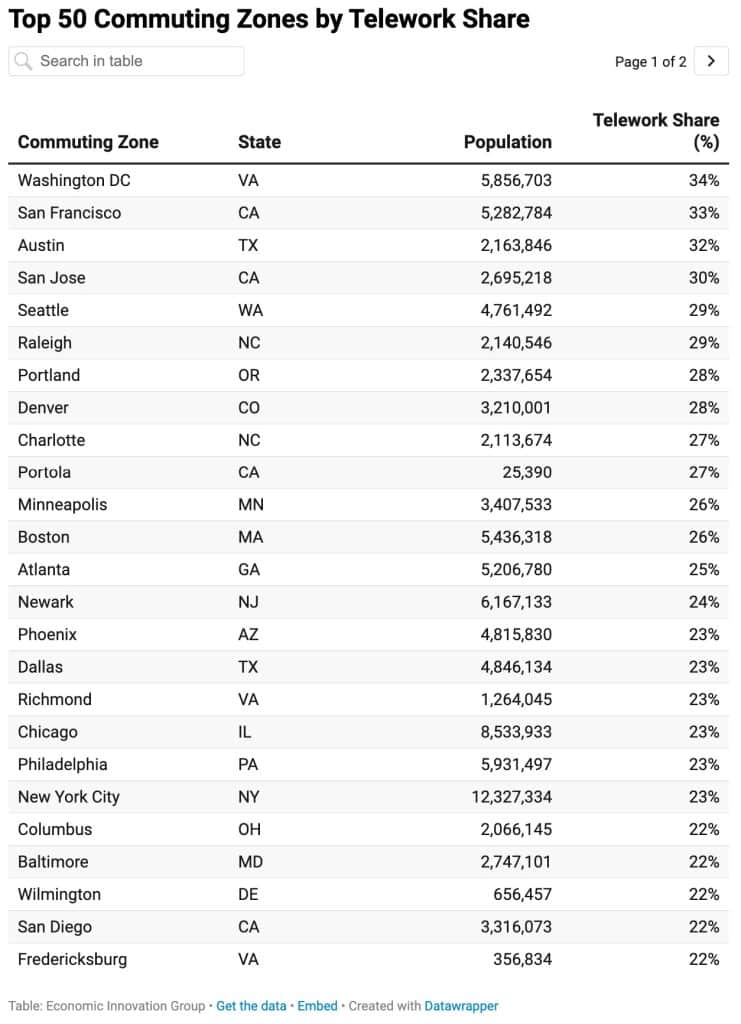According to the Economic Innovation Group research, at least 42 locations across the nation had at least 20% of the population working remotely as of the previous year. Across the country, remote work increased from 5.6% in 2019, before the pandemic, to 17.9% in 2021.
Underneath that overall statistic, the new EIG report examines how the popularity of remote work has radically changed in “commuting zones” around various cities.
Data on the most popular locations for remote work were lacking until recently. But as population growth and decline are influenced by remote work, local officials can evaluate how their areas compare with other communities once the 2021 American Community Survey data, on which the EIG research is based, is released.
“I think it’s important to understand whether you’re on one side of the ledger, or maybe in some ways you’re on both sides,” Adam Ozimek, the report’s co-author, told Route Fifty.

Some of the regions that had the highest percentage of remote workers last year are perhaps not entirely surprising. With 34% of residents working remotely, the Washington, D.C. metropolitan area tops the list, followed by San Francisco (33%) and Austin, Texas (32%).

Source
But other cities not as commonly associated with the software industry or the so-called creative class as the boomtowns have also seen an increase in remote work.
For example, 22% of the 650,000 residents in the Wilmington, Delaware, area that the EIG survey examined worked remotely. The same was true for 22% of the roughly 237,000 residents of Santa Fe, New Mexico, and surrounding areas, and for 21% of the 637,000 residents in the Provo, Utah, area.
“Remote workers are moving away from the most expensive places, and remote work gives people an incentive to find lower cost living places,” Ozimek said.
Over the past year, as the pandemic has subsided, more people have returned to work. According to Ozimek, however, he does not expect the types of migration documented in the data to disappear. He cites a study he authored earlier this year showing that for every person who moved because of remote work, four people planned to move.
“That suggests that a lot of the impact is still yet to come,” he said.
The paper examines commuting zones, which are groups of counties where individuals go to work.
According to research by Ozimek and his co-author Eric Carlson, 13.7% of the population of the country resided in areas where remote work rates exceeded 25% in 2016.
Education levels, housing costs, lengthy commutes, and the types of jobs that are available are just a few of the many variables that might increase or decrease the amount of remote work in certain geographic areas.
The paper examines commuting zones, which are groups of counties where individuals go to work.
According to research by Ozimek and his co-author Eric Carlson, 13.7% of the population of the country resided in areas where remote work rates exceeded 25% in 2016.
Education levels, housing costs, lengthy commutes, and the types of jobs that are available are just a few of the many variables that might increase or decrease the amount of remote work in certain geographic areas.
If residing close to large businesses is no longer a major draw, cities that are losing citizens due to remote work may need to find other strategies to recruit people.
“It turns the focus more on the quality of life issues, and sort of turns it away from a traditional economic development focus, which is, ‘how do we get big employers here?’” Ozimek said.
The post Data Reveals U.S. Cities Where Remote Workers Cover Up To 34% Of The Population appeared first on Traveling Lifestyle.
-----------------------------
By: Viktor Vincej
Title: Data Reveals U.S. Cities Where Remote Workers Cover Up To 34% Of The Population
Sourced From: www.travelinglifestyle.net/data-reveals-u-s-cities-where-remote-workers-cover-up-to-34-of-the-population/
Published Date: Tue, 25 Oct 2022 15:05:09 +0000
Read More
 Privacy PolicyTerms And Conditions
Privacy PolicyTerms And Conditions
